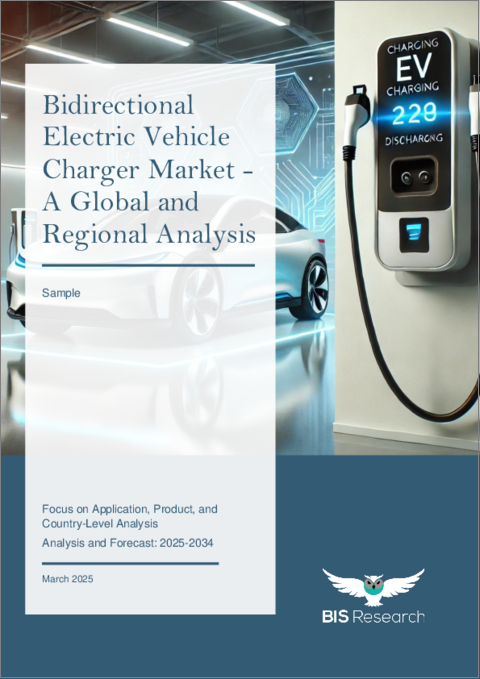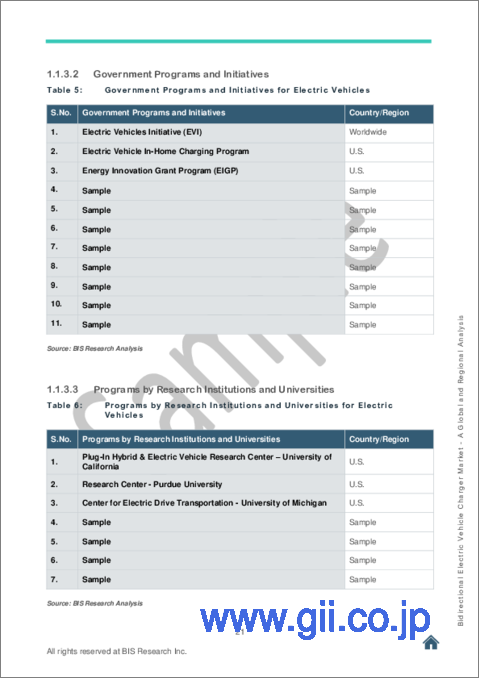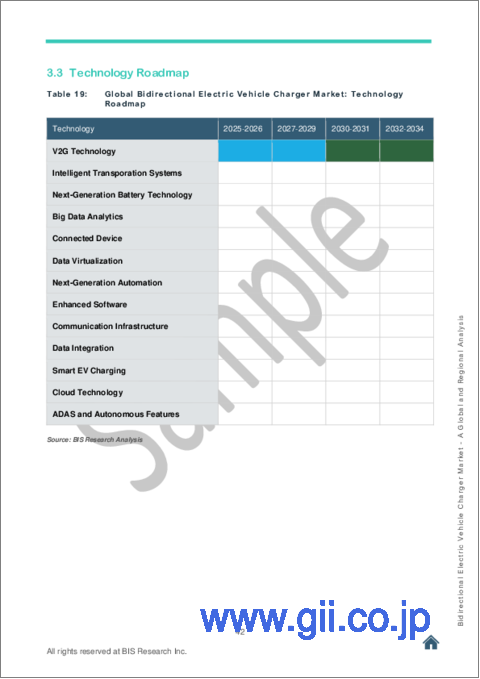|
|
市場調査レポート
商品コード
1679112
双方向電気自動車充電器市場- 世界および地域別分析:用途別、製品別、国別 - 分析と予測(2025年~2034年)Bidirectional Electric Vehicle Charger Market - A Global and Regional Analysis: Focus on Application, Product, and Country-Level Analysis - Analysis and Forecast, 2025-2034 |
||||||
カスタマイズ可能
|
|||||||
| 双方向電気自動車充電器市場- 世界および地域別分析:用途別、製品別、国別 - 分析と予測(2025年~2034年) |
|
出版日: 2025年03月14日
発行: BIS Research
ページ情報: 英文 150 Pages
納期: 1~5営業日
|
全表示
- 概要
- 目次
双方向電気自動車(EV)充電器市場は、いくつかの理由から初期成長段階にあります。
まず、双方向充電技術は比較的新しいコンセプトであるため、まだ市場に完全に浸透していません。この技術により、電気自動車はグリッドからエネルギーを消費するだけでなく、それをグリッドにフィードバックし、グリッド・サービスを提供し、グリッドの全体的な安定性と回復力を高めることができます。第二に、電気自動車の普及はまだ初期段階にあります。しかし、より環境に優しいモビリティへの需要が高まり、バッテリー技術のコストが低下していることから、電気自動車の採用は今後数年で増加すると予想されます。より多くの電気自動車が道路を走るようになれば、双方向充電の需要も増加すると見込まれています。最後に、双方向充電が提供できる周波数調整などのグリッド・サービスへのニーズが高まっています。さらに、太陽光や風力エネルギーは本質的に断続的であり、グリッドのバランスを取るために双方向充電のような柔軟なソリューションが必要となるため、グリッドミックスにおける再生可能エネルギーの割合が増えるにつれて、このニーズは高まると予想されます。その結果、双方向電気自動車充電器市場は予測期間中に繁栄すると予想されます。
持続可能なエネルギーへのシフトに伴い、ソーラーパネルや風力タービンのような再生可能エネルギーを送電網に統合する需要が増加しています。双方向EV充電技術により、電気自動車用バッテリーは、再生可能エネルギーが利用可能な時には余剰エネルギーを蓄え、不足時にはグリッドに供給することができます。
EVの普及が進むにつれ、充電インフラの需要も増加しています。双方向EV充電は、EVがグリッドから電力を受け取るだけでなく、ピーク時に電力を送り返すことを可能にすることで、充電インフラを改善する機会を提供します。
双方向充電技術により、EV所有者は、車両バッテリーに蓄積された余剰エネルギーをグリッドに売ったり、ピーク需要時に使用したりすることができます。この機能により、EVオーナーはエネルギーコストを削減でき、場合別は利益を得ることもできます。
世界中のさまざまな政府が、双方向EV充電技術の採用を促進するため、税額控除や補助金などのインセンティブを提供しています。これは、メーカーがこれらの製品の研究開発に投資することを奨励しています。
最近の電気自動車とバッテリー技術の進歩により、双方向充電システムの効率と信頼性が向上し、普及に向けたより実用的な選択肢となっています。
当レポートでは、世界の双方向電気自動車充電器市場について調査し、市場の概要とともに、用途別、製品別、国別の動向、および市場に参入する企業のプロファイルなどを提供しています。
目次
エグゼクティブサマリー
第1章 市場:業界の展望
- 動向:現在および将来の影響評価
- ステークホルダー分析
- 市場力学の概要
- 規制状況
- 特許分析
- スタートアップの情勢
- コストと価格分析
- 今後の展望と市場ロードマップ
- サプライチェーン分析
- バリューチェーン分析
- 世界価格分析
- 業界の魅力
- 双方向電気自動車充電器の技術分析
- 双方向充電器への道:グリッド統合レベル
- 技術ロードマップ
第2章 双方向電気自動車充電器市場(用途別)
- 製品セグメンテーション別用途
- 製品別用途のサマリー
- 双方向電気自動車充電器市場(用途別)
- 双方向電気自動車充電器市場(由来別)
- 双方向電気自動車充電器市場(推進タイプ別)
第3章 双方向電気自動車充電器市場(製品別)
- 製品セグメンテーション
- 製品のサマリー
- 双方向電気自動車充電器市場(充電器の導入状況別)
- 双方向電気自動車充電器市場(充電タイプ別)
第4章 双方向電気自動車充電器市場(地域別)
- 双方向電気自動車充電器市場(地域別)
- 北米
- 欧州
- アジア太平洋
- その他の地域
第5章 市場-競合ベンチマーキングと企業プロファイル
- 今後の見通し
- 地理的評価
- 企業プロファイル
- Wallbox Chargers, S.L.
- Indra Renewable Technologies Limited
- Delta Electronics, Inc.
- Fermata Energy
- Power Research Electronics B.V.
- Hyundai Mobis Co. Ltd.
- ABB
- Blink Charging Co.
- Siemens AG
- Denso Corporation
- Hitachi Automotive Systems, Ltd.
- Toyota Industries Corporation
- MAGNUM CAP
- Enphase Energy, Inc.
- Autel Energy
- The Mobility House GmbH
- EVBox
- JET Charge Pty Ltd
- Emporia Corporation
- Elinta Charge
第6章 調査手法
Bidirectional Electric Vehicle Charger Market Lifecycle Stage
The bidirectional electric vehicle (EV) charger market is in the early growth phase for several reasons. Firstly, bidirectional charging technology is a relatively new concept, and as such, it has not yet penetrated the market fully. This technology enables electric vehicles to not just consume energy from the grid but also feed it back to the grid, providing grid services and enhancing the overall stability and resiliency of the grid. Secondly, the adoption of electric vehicles is still in its early stages. However, with the increasing demand for greener mobility and the decreasing cost of battery technology, the adoption of electric vehicles is expected to increase in the coming years. As more and more electric vehicles hit the road, the demand for bidirectional charging will increase. Lastly, there is a growing need for grid services such as frequency regulation, which bidirectional charging can provide. Additionally, this need is expected to grow as the share of renewable energy in the grid mix increases, as solar and wind energy are inherently intermittent and require flexible solutions like bidirectional charging to help balance the grid. As a result, the bidirectional electric vehicle charger market is expected to flourish in the forecast period.
Impact
There are several factors driving the growth of the bidirectional electric vehicle (EV) charger market:
1. Increased Demand for Renewable Energy Integration: With the world shifting toward sustainable energy, there has been an increase in demand for integrating renewable energy sources like solar panels and wind turbines into the grid. Bidirectional EV charging technology allows electric vehicle batteries to store excess renewable energy when it is available and feed it back into the grid when there is a shortage.
2. Growing EV Penetration: As the adoption of EVs continues to grow, the demand for charging infrastructure is also increasing. Bidirectional EV charging provides an opportunity to improve charging infrastructure by allowing EVs to not only receive electricity from the grid but also send it back during peak demand.
3. Reduced Energy Costs: Bidirectional charging technology enables EV owners to sell excess energy stored in their vehicle batteries back to the grid or use it during peak demand hours. This feature can help EV owners reduce their energy costs and even earn profits in some cases.
4. Government Incentives: Various governments around the world are providing incentives such as tax credits and subsidies to promote the adoption of bidirectional EV charging technology. This has encouraged manufacturers to invest in research and development of these products.
5. Advancements in Technology: Recent advancements in electric vehicle and battery technology have improved the efficiency and reliability of bidirectional charging systems, making them a more practical option for widespread deployment.
Bidirectional Electric Vehicle Charger Market Segmentation:
Segmentation 1: by Application
- Vehicle-to-Grid (V2G)
- Vehicle-to-Home (V2H)
- Others (Vehicle-to-Vehicle and Vehicle-to-Load)
Segmentation 2: by Source
- OEM
- Aftermarket
Segmentation 3: by Propulsion Type
- Battery Electric Vehicle (BEV)
- Plug-in Hybrid Electric Vehicle (PHEV)
The bidirectional electric vehicle charger market based on the propulsion type segment is expected to be dominated by the BEV segment throughout the forecast period 2025-2034. Based on the application, the V2G segment is expected to dominate the market throughout the forecast period. Moreover, based on the source, the OEM segment is anticipated to dominate the market during the forecast period.
Segmentation 4: by Deployment of Charger
- Domestic
- Commercial
Segmentation 5: by Charging Type
- <20 kWh
- 20-40 kWh
- 40-100 kWh
- >100 kWh
Based on the deployment of charger, the domestic segment is expected to dominate the market, and based on charging type, the <20 kWh is likely to dominate the market, offering a wide scope of development in the forecast period.
Segmentation 6: by Region
- North America
- Europe
- Asia-Pacific
- Rest-of-the-World
Europe is home to several electric vehicle manufacturers as well as bidirectional electric vehicle charger providers. Hence, the region is expected to dominate the bidirectional electric vehicle charger market during the forecast period.
Recent Developments in the Bidirectional Electric Vehicle Charger Market
- In October 2021, WALLBOX Inc. partnered with Nuvve Holding Corporation for a pioneering vehicle-to-grid (V2G) cooperation in Iberia aimed at easing grid load and providing users with substantial financial incentives.
- In October 2022, Indra, in collaboration with Manchester University NHS Foundation Trust (MFT) and Hitachi ZeroCarbon, a division of Hitachi Europe, released the findings from the first-ever NHS initiative to deploy ground-breaking vehicle-to-grid (V2G) technology after five Hitachi-funded Indra V2G chargers were installed for electric pharmacy truck fleet. The Trust received an average 6 per kWh drop in electricity costs.
- In December 2022, Fermata Energy and Phoenix Motorcars formed a long-term partnership for V2X bidirectional charging. According to the deal, Fermata Energy would integrate Phoenix's zero-emission drive system with its V2X bidirectional chargers and AI-driven software platform.
- In February 2020, a publicly financed V2G technology demonstration project received the all-clear in Japan in partnership with Mitsubishi. In several places throughout Japan, a vehicle-to-grid charging network for BEVs and PHEVs is to be established by 2025.
Demand - Drivers and Limitations
The following are the demand drivers for the Bidirectional Electric Vehicle Charger Market:
- Growing Numbers of Electric Vehicles Worldwide
- Government Initiatives for the Development of Electric Vehicle Charging Infrastructure
- Need for Energy Self-Sufficiency
- Advent of Intelligent Transportation Systems
The bidirectional electric vehicle charger market is expected to face some limitations as well due to the following challenges:
- Lack of Standardization of Electric Vehicle (EV) Charging
- Lack of Government Support in Bidirectional Charging
- Reduced Battery Durability and Battery Efficiency of Vehicles due to Charging Lifecycles
- Batteries Overheat Issue in Prolonged Bidirectional Charging
How can this report add value to an organization?
Product/Innovation Strategy: The product segment helps the reader understand the different applications of the available based on source (OEM and aftermarket), application (vehicle to grid, vehicle to home, and others (vehicle to vehicle and vehicle to load)), propulsion type (BEV and PHEV), deployment of charger (domestic and commercial), and charging type (<20 kWh, 20-40 kWh, 40-100 kWh, and >100 kWh). Increasing demand for electric vehicles is pushing the consumption of bidirectional electric vehicle charging. Therefore, the bidirectional electric vehicle charging business is a high-investment and high-revenue generating model.
Growth/Marketing Strategy: The bidirectional electric vehicle charger market is an exponentially growing market holding enormous opportunities for the market players. Some strategies covered in this segment are product launches, market developments, partnerships and collaborations, business expansions, and investments. The companies' preferred strategy has been market developments, partnerships, and collaborations to strengthen their positions in the global bidirectional electric vehicle charger market.
Competitive Strategy: Key players in the global bidirectional electric vehicle charger market analyzed and profiled in the study involve bidirectional electric charger manufacturers. Moreover, a detailed competitive benchmarking of the players operating in the global bidirectional electric vehicle charger market has been done to help the reader understand how players stack against each other, presenting a clear market landscape. Additionally, comprehensive competitive strategies such as partnerships, agreements, and collaborations will aid the reader in understanding the untapped revenue pockets in the market.
Key Market Players and Competition Synopsis
The companies that are profiled have been selected based on inputs gathered from primary experts and analyzing company coverage, product portfolio, and bidirectional electric vehicle charger market penetration.
The competitive landscape of the bidirectional electric vehicle charger market includes different strategies undertaken by bidirectional charger manufacturers to gain market presence. Some strategies adopted by them include new product launch and development activities, market development activities, partnerships, collaborations, joint ventures, and mergers and acquisitions. Among all the strategies adopted, market development activities have dominated the competitive landscape and are the most widely adopted strategies among service providers.
Some prominent names in this bidirectional electric vehicle charger market are:
- Indra Renewable Technologies Limited
- Delta Electronics, Inc.
- Emporia Corp.
- Tsubakimoto Chain Co.
- Wallbox Chargers, S.L.
- Power Research Electronics B.V.
- ABB
- Hyundai Mobis
- Siemens AG
- E.ON SE
- Enel Spa
- JET Charge Pty Ltd
- MAGNUM CAP
- Fermata Energy
- Rectifier Technologies
- Autel Energy
- The Mobility House
- Denso Corporation
- Hitachi
- Blink Charging Co
- Toyota
Companies that are not a part of the aforementioned pool have been well represented across different sections of the report (wherever applicable).
Table of Contents
Executive Summary
Scope and Definition
Market/Product Definition
Key Questions Answered
Analysis and Forecast Note
1. Markets: Industry Outlook
- 1.1 Trends: Current and Future Impact Assessment
- 1.2 Stakeholder Analysis
- 1.2.1 Use Case
- 1.2.2 End User and Buying Criteria
- 1.3 Market Dynamics Overview
- 1.3.1 Market Drivers
- 1.3.2 Market Restraints
- 1.3.3 Market Opportunities
- 1.4 Regulatory Landscape
- 1.5 Patent Analysis
- 1.6 Start-Up Landscape
- 1.7 Cost & Pricing Analysis
- 1.8 Future Outlook and Market Roadmap
- 1.9 Supply Chain Analysis
- 1.10 Value Chain Analysis
- 1.11 Global Pricing Analysis
- 1.12 Industry Attractiveness
- 1.13 Technical Analysis of Bidirectional Electric Vehicle Charger
- 1.14 The Road to Bidirectional Chargers: Grid Integration Levels
- 1.15 Technology Roadmap
2. Bidirectional Electric Vehicle Charger Market (By Application)
- 2.1 Application by Product Segmentation
- 2.2 Application by Product Summary
- 2.3 Bidirectional Electric Vehicle Charger Market (by Application)
- 2.3.1 Vehicle-to-Grid (V2G)
- 2.3.2 Vehicle-to-Home (V2H)
- 2.3.3 Others
- 2.4 Bidirectional Electric Vehicle Charger Market (by Source)
- 2.4.1 OEM
- 2.4.2 Aftermarket
- 2.5 Bidirectional Electric Vehicle Charger Market (by Propulsion Type)
- 2.5.1 Battery Electric Vehicles (BEVs)
- 2.5.2 Plug-in Hybrid Electric Vehicles (PHEVs)
3. Bidirectional Electric Vehicle Charger Market (by Product)
- 3.1 Product Segmentation
- 3.2 Product Summary
- 3.3 Bidirectional Electric Vehicle Charger Market (by Deployment of Charger)
- 3.3.1 Domestic
- 3.3.2 Commercial
- 3.4 Bidirectional Electric Vehicle Charger Market (by Charging Type)
- 3.4.1 <20 kWh
- 3.4.2 20-40 kWh
- 3.4.3 40-100 kWh
- 3.4.4 >100 kWh
4. Bidirectional Electric Vehicle Charger Market (by region)
- 4.1 Bidirectional Electric Vehicle Charger Market (by Region)
- 4.2 North America
- 4.2.1 Regional Overview
- 4.2.2 Driving Factors for Market Growth
- 4.2.3 Factors Challenging the Market
- 4.2.4 Key Companies
- 4.2.5 Application
- 4.2.6 Product
- 4.2.7 U.S.
- 4.2.7.1 Market by Application
- 4.2.7.2 Market by Product
- 4.2.8 Canada
- 4.2.8.1 Market by Application
- 4.2.8.2 Market by Product
- 4.2.9 Mexico
- 4.2.9.1 Market by Application
- 4.2.9.2 Market by Product
- 4.3 Europe
- 4.3.1 Regional Overview
- 4.3.2 Driving Factors for Market Growth
- 4.3.3 Factors Challenging the Market
- 4.3.4 Key Companies
- 4.3.5 Application
- 4.3.6 Product
- 4.3.7 Germany
- 4.3.7.1 Market by Application
- 4.3.7.2 Market by Product
- 4.3.8 France
- 4.3.8.1 Market by Application
- 4.3.8.2 Market by Product
- 4.3.9 U.K.
- 4.3.9.1 Market by Application
- 4.3.9.2 Market by Product
- 4.3.10 Italy
- 4.3.10.1 Market by Application
- 4.3.10.2 Market by Product
- 4.3.11 The Netherlands
- 4.3.11.1 Market by Application
- 4.3.11.2 Market by Product
- 4.3.12 Nordic Countries
- 4.3.12.1 Market by Application
- 4.3.12.2 Market by Product
- 4.3.13 Rest-of-Europe
- 4.3.13.1 Market by Application
- 4.3.13.2 Market by Product
- 4.4 Asia-Pacific
- 4.4.1 Regional Overview
- 4.4.2 Driving Factors for Market Growth
- 4.4.3 Factors Challenging the Market
- 4.4.4 Ongoing Projects
- 4.4.5 Key Companies
- 4.4.6 Application
- 4.4.7 Product
- 4.4.8 China
- 4.4.8.1 Market by Application
- 4.4.8.2 Market by Product
- 4.4.9 Japan
- 4.4.9.1 Market by Application
- 4.4.9.2 Market by Product
- 4.4.10 India
- 4.4.10.1 Market by Application
- 4.4.10.2 Market by Product
- 4.4.11 South Korea
- 4.4.11.1 Market by Application
- 4.4.11.2 Market by Product
- 4.4.12 Rest-of-Asia-Pacific
- 4.4.12.1 Market by Application
- 4.4.12.2 Market by Product
- 4.5 Rest-of-the-World
- 4.5.1 Regional Overview
- 4.5.2 Driving Factors for Market Growth
- 4.5.3 Factors Challenging the Market
- 4.5.4 Ongoing Projects
- 4.5.5 Key Companies
- 4.5.6 Application
- 4.5.7 Product
- 4.5.8 South America
- 4.5.8.1 Market by Application
- 4.5.8.2 Market by Product
- 4.5.9 Middle East and Africa
- 4.5.9.1 Market by Application
- 4.5.9.2 Market by Product
5. Markets - Competitive Benchmarking & Company Profiles
- 5.1 Next Frontiers
- 5.2 Geographic Assessment
- 5.3 Company Profiles
- 5.3.1 Wallbox Chargers, S.L.
- 5.3.1.1 Overview
- 5.3.1.2 Top Products/Product Portfolio
- 5.3.1.3 Top Competitors
- 5.3.1.4 Target Customers
- 5.3.1.5 Key Personnel
- 5.3.1.6 Analyst View
- 5.3.1.7 Market Share
- 5.3.2 Indra Renewable Technologies Limited
- 5.3.2.1 Overview
- 5.3.2.2 Top Products/Product Portfolio
- 5.3.2.3 Top Competitors
- 5.3.2.4 Target Customers
- 5.3.2.5 Key Personnel
- 5.3.2.6 Analyst View
- 5.3.2.7 Market Share
- 5.3.3 Delta Electronics, Inc.
- 5.3.3.1 Overview
- 5.3.3.2 Top Products/Product Portfolio
- 5.3.3.3 Top Competitors
- 5.3.3.4 Target Customers
- 5.3.3.5 Key Personnel
- 5.3.3.6 Analyst View
- 5.3.3.7 Market Share
- 5.3.4 Fermata Energy
- 5.3.4.1 Overview
- 5.3.4.2 Top Products/Product Portfolio
- 5.3.4.3 Top Competitors
- 5.3.4.4 Target Customers
- 5.3.4.5 Key Personnel
- 5.3.4.6 Analyst View
- 5.3.4.7 Market Share
- 5.3.5 Power Research Electronics B.V.
- 5.3.5.1 Overview
- 5.3.5.2 Top Products/Product Portfolio
- 5.3.5.3 Top Competitors
- 5.3.5.4 Target Customers
- 5.3.5.5 Key Personnel
- 5.3.5.6 Analyst View
- 5.3.5.7 Market Share
- 5.3.6 Hyundai Mobis Co. Ltd.
- 5.3.6.1 Overview
- 5.3.6.2 Top Products/Product Portfolio
- 5.3.6.3 Top Competitors
- 5.3.6.4 Target Customers
- 5.3.6.5 Key Personnel
- 5.3.6.6 Analyst View
- 5.3.6.7 Market Share
- 5.3.7 ABB
- 5.3.7.1 Overview
- 5.3.7.2 Top Products/Product Portfolio
- 5.3.7.3 Top Competitors
- 5.3.7.4 Target Customers
- 5.3.7.5 Key Personnel
- 5.3.7.6 Analyst View
- 5.3.7.7 Market Share
- 5.3.8 Blink Charging Co.
- 5.3.8.1 Overview
- 5.3.8.2 Top Products/Product Portfolio
- 5.3.8.3 Top Competitors
- 5.3.8.4 Target Customers
- 5.3.8.5 Key Personnel
- 5.3.8.6 Analyst View
- 5.3.8.7 Market Share
- 5.3.9 Siemens AG
- 5.3.9.1 Overview
- 5.3.9.2 Top Products/Product Portfolio
- 5.3.9.3 Top Competitors
- 5.3.9.4 Target Customers
- 5.3.9.5 Key Personnel
- 5.3.9.6 Analyst View
- 5.3.9.7 Market Share
- 5.3.10 Denso Corporation
- 5.3.10.1 Overview
- 5.3.10.2 Top Products/Product Portfolio
- 5.3.10.3 Top Competitors
- 5.3.10.4 Target Customers
- 5.3.10.5 Key Personnel
- 5.3.10.6 Analyst View
- 5.3.10.7 Market Share
- 5.3.11 Hitachi Automotive Systems, Ltd.
- 5.3.11.1 Overview
- 5.3.11.2 Top Products/Product Portfolio
- 5.3.11.3 Top Competitors
- 5.3.11.4 Target Customers
- 5.3.11.5 Key Personnel
- 5.3.11.6 Analyst View
- 5.3.11.7 Market Share
- 5.3.12 Toyota Industries Corporation
- 5.3.12.1 Overview
- 5.3.12.2 Top Products/Product Portfolio
- 5.3.12.3 Top Competitors
- 5.3.12.4 Target Customers
- 5.3.12.5 Key Personnel
- 5.3.12.6 Analyst View
- 5.3.12.7 Market Share
- 5.3.13 MAGNUM CAP
- 5.3.13.1 Overview
- 5.3.13.2 Top Products/Product Portfolio
- 5.3.13.3 Top Competitors
- 5.3.13.4 Target Customers
- 5.3.13.5 Key Personnel
- 5.3.13.6 Analyst View
- 5.3.13.7 Market Share
- 5.3.14 Enphase Energy, Inc.
- 5.3.14.1 Overview
- 5.3.14.2 Top Products/Product Portfolio
- 5.3.14.3 Top Competitors
- 5.3.14.4 Target Customers
- 5.3.14.5 Key Personnel
- 5.3.14.6 Analyst View
- 5.3.14.7 Market Share
- 5.3.15 Autel Energy
- 5.3.15.1 Overview
- 5.3.15.2 Top Products/Product Portfolio
- 5.3.15.3 Top Competitors
- 5.3.15.4 Target Customers
- 5.3.15.5 Key Personnel
- 5.3.15.6 Analyst View
- 5.3.15.7 Market Share
- 5.3.16 The Mobility House GmbH
- 5.3.16.1 Overview
- 5.3.16.2 Top Products/Product Portfolio
- 5.3.16.3 Top Competitors
- 5.3.16.4 Target Customers
- 5.3.16.5 Key Personnel
- 5.3.16.6 Analyst View
- 5.3.16.7 Market Share
- 5.3.17 EVBox
- 5.3.17.1 Overview
- 5.3.17.2 Top Products/Product Portfolio
- 5.3.17.3 Top Competitors
- 5.3.17.4 Target Customers
- 5.3.17.5 Key Personnel
- 5.3.17.6 Analyst View
- 5.3.17.7 Market Share
- 5.3.18 JET Charge Pty Ltd
- 5.3.18.1 Overview
- 5.3.18.2 Top Products/Product Portfolio
- 5.3.18.3 Top Competitors
- 5.3.18.4 Target Customers
- 5.3.18.5 Key Personnel
- 5.3.18.6 Analyst View
- 5.3.18.7 Market Share
- 5.3.19 Emporia Corporation
- 5.3.19.1 Overview
- 5.3.19.2 Top Products/Product Portfolio
- 5.3.19.3 Top Competitors
- 5.3.19.4 Target Customers
- 5.3.19.5 Key Personnel
- 5.3.19.6 Analyst View
- 5.3.19.7 Market Share
- 5.3.20 Elinta Charge
- 5.3.20.1 Overview
- 5.3.20.2 Top Products/Product Portfolio
- 5.3.20.3 Top Competitors
- 5.3.20.4 Target Customers
- 5.3.20.5 Key Personnel
- 5.3.20.6 Analyst View
- 5.3.20.7 Market Share
- 5.3.1 Wallbox Chargers, S.L.






